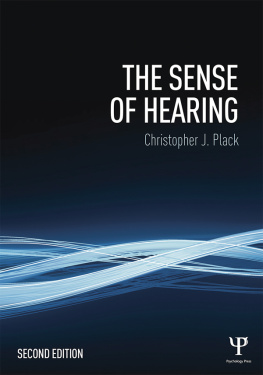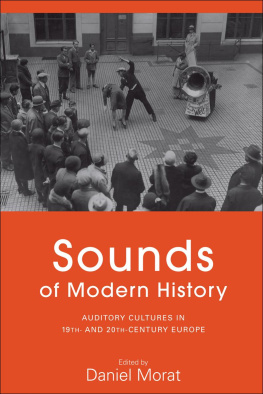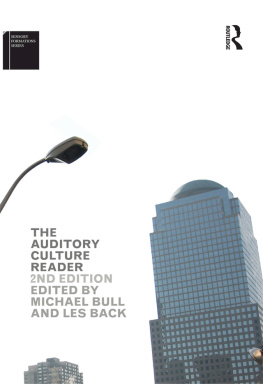Our senses provide us with the information that allows us to interact with the world in a meaningful way. Hearing is the sense that obtains information about the world using the pressure fluctuations in the air (i.e., sounds) that are produced by vibrating objects. In most situations in which we find ourselves, the air is full of sound, and it is therefore full of information. Much of this information is generated, directly or indirectly, by other life-forms. The ear evolved to make use of that information, to make us better at coping with the struggle for existence, as Charles Darwin (1859) put it. In this chapter, I explain why I think that hearing is a worthwhile subject for study and give an overview of the delights to follow in this volume.
In most undergraduate psychology courses, the study of hearing is neglected in favor of the study of vision. Is this bias justified? I argue that it is not. Hearing is a crucial sense for humans. Speech is the main means by which we communicate with one another. Music is one of the most important forms of entertainment and recreation, as well as being an important form of communication itselfit allows the expression of powerful emotions. Hearing is, therefore, central to the interaction of human beings with other human beings. Hearing is also of importance to our interactions with our environment. Sounds warn us of danger: In many situations, we hear an approaching car before we see it. Sounds are also used in our interactions with objects. They wake us up in the morning and provide information about the operation of machines, from car engines to smartphones.
We study hearing to understand how the ear and the brain make sense of these stimuli, which are such an integral part of our daily lives. Despite the importance of knowledge in itself for our culture (and the promise that pure research will eventually lead to useful applications), hearing research is not driven by curiosity alone. If we understand how the auditory system responds to sounds, then we can use that knowledge to help design sound-producing devices, such as telecommunication systems, entertainment systems, and devices that produce auditory alerts and warnings. We can use that knowledge to design buildings and plan towns and cities, to give their inhabitants a more intelligible, and beneficial, acoustic environment. We can also use our knowledge of how the human auditory system works to design artificial devices that mimic aspects of this system, such as speech recognition programs that enable us to talk to our machines. Last but not least, this knowledge helps us to understand and manage hearing disorders. About one in six people are hearing impaired. The development of diagnostic techniques and interventions such as hearing aids is dependent on perceptual research.
There is a great deal of ignorance about hearing, probably more than there is regarding vision. Many people are aware of how the eye works, at least in general terms. They know that light from an object is focused by the lens onto the retina. How many people know what happens to sounds in the ear? Very few, on the basis of my experience. Even if you believe that vision is the most important sense and that this should be reflected in teaching practices, I hope you will agree that we should not neglect hearing. If you are approaching this subject for the first time, I would like to convince you that auditory science is not only important but also fascinating .
This book provides an introduction to auditory perception; it explains how sounds are represented and analyzed in the auditory system and how these processes cause the sensations that we experience when we listen to sounds. The description will mostly be a mix of auditory psychophysics (or psychoacoustics ), which is the study of the relations between sounds and sensations, and auditory anatomy and physiology, which is the study of the biological hardware involved. To start, however, a little background is needed for readers who are not familiar with the physics of sound. , in which our sensations are related to processes in the cochlea and at other stages in the auditory system.
The next few chapters cover auditory sensations that should be familiar to most readers. Our perception of sound magnitude, or loudness, is discussed in summarizes what we know and what we do not know about auditory perception, and the Appendix provides an overview of the experimental methodologies that we use to study the auditory system.
12
Music
After speech, music is arguably the most important type of sound stimulus for humans. But music remains something of a mystery. It seems to satisfy no obvious biological need, yet it has the power to move us in ways that few other forms of human expression can. Music is strongly linked to our emotional response and can evoke feelings of sadness, happiness, excitement, and calm. Why do certain combinations of notes and rhythms have the ability to affect us in this way?
Music is composed of sound waves, and as such it is analyzed and processed, at least initially, in the same ways as all the other sounds that enter our ears. Musical instruments have different timbres, the perception of which depends on the frequency selective properties of the ear described in .
In this chapter, I will discuss the perception of music in relation to what we have learned so far in the book about the mechanisms of hearing. I will also provide a brief introduction to higher level processes such as memory and emotion. Finally, I will describe some of the theories that have been proposed to explain the most puzzling aspect of the story: why music exists at all.
We might think that we have a pretty good idea of what is music; we generally know it when we hear it. But music is actually quite difficult to define. In his famous dictionary, Samuel Johnson defined musick as the science of harmony or instrumental or vocal harmony (Johnson, 1768), a definition that assumes music is a consequence of sound production by tonal instruments such as the violin. However, more recent composers have transformed our ideas regarding the sorts of sounds that can be regarded as musical. The innovative composer Edgard Varse (18831965) defined music simply as organized sound (Goldman, 1961). This could include anything from a melody played by a flute to the combined sound of a waterfall and a train. The online resource dictionary.com defines music as an art of sound in time that expresses ideas and emotions in significant forms through the elements of rhythm, melody, harmony, and color. This seems to be a fairly comprehensive definition, although the use of the word color is a little ambiguous. In what follows, I am going to err on the conservative side and start by focusing on the building blocks of what might be considered traditional Western music, in particular the aspects related to pitch (melody and harmony) and the aspects related to time (tempo, rhythm, and meter).
12.2.1 Musical notes and the pitch helix
A musical note can be defined as a sound with a pitch (e.g., a complex tone with a specific fundamental frequency) or, alternatively, as a symbolic representation of such a sound (e.g., the note A, or a symbol used in standard musical notation). There are certain restrictions on the range of fundamental frequencies that are commonly used. In Western music, the permitted notes have specific fundamental frequencies, with adjacent notes separated by a musical interval of a semitone, which is about a 6% change in fundamental frequency. Notes are given standard labels: A, A/B, B, C, C/D, D, D/E, E, F, F/G, G, G/A. represents sharp (a semitone above the note given by the letter or symbol) and represents flat (a semitone below the note given by the letter or symbol). Equal temperament tuning (such as that used to tune a piano) is based on a constant frequency ratio (about 1.06:1) between adjacent notes separated by a semitone. In this type of tuning, A and B are the same note, as are C and D, D and E, and G and A. But for an instrument that can play a continuous range of fundamental frequencies (such as the violin or trombone), A and B (etc.) can have slightly different fundamental frequencies, depending on the key the piece is in (see Section 12.2.2).







